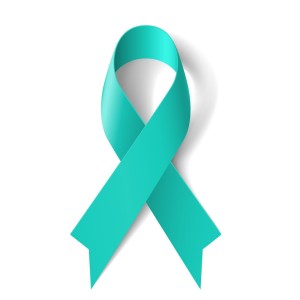 September is “back to school” and in the Balanced Beauty world, it’s “Ovarian Cancer Awareness Month.”
September is “back to school” and in the Balanced Beauty world, it’s “Ovarian Cancer Awareness Month.”
Please read the below facts from the American Cancer Society and The National Ovarian Cancer Coalition to educate yourself! Share with a friend, sister, daughter, mom or loved one…Women need to be aware of this life threatening disease and the importance of preventative health care.
What is Ovarian Cancer?
Ovarian cancer is a disease in which malignant or cancerous cells are found in the ovaries. An ovary is one of two small, almond-shaped organs located on each side of the uterus that store eggs or germ cells and produce female hormones estrogen and progesterone.
Cancer Basics:
Cancer develops when cells in a part of the body (in this case the ovary) begin to grow out of control. Although there are many kinds of cancer, they all start because of out-of-control growth of abnormal cells.
Normally, cells in your body divide, and form new cells to replace worn out or dying cells and to repair injuries. Because cancer cells continue to grow and divide, they are different from normal cells. Instead of dying, they outlive normal cells and continue to create new abnormal cells forming a tumor. Tumors can put pressure on other organs lying near the ovaries.
Cancer cells sometimes can travel to other parts of the body where they begin to grow and replace normal tissue. This process, called metastasis, occurs as the cancer cells move into the bloodstream or lymph vessels of our body. Cancer cells that spread from other organ sites (such as breast or colon) to the ovary are not considered ovarian cancer
There are many types of tumors that can start in the ovaries. Some are benign, or noncancerous, and the patient can be cured by surgically removing one ovary or the part of the ovary containing the tumor. Some are malignant or cancerous. The treatment options and the outcome for the patient depend on the type of ovarian cancer and how far it has spread before it is diagnosed.
 What is the general outlook for women diagnosed with ovarian cancer?
What is the general outlook for women diagnosed with ovarian cancer?
In women age 35-74, ovarian cancer is the fifth leading cause of cancer-related deaths. An estimated one woman in 75 will develop ovarian cancer during her lifetime. The American Cancer Society estimates that there will be over 22,000 new cases of ovarian cancer diagnosed this year and that more than 15,000 women will die from ovarian cancer this year.
When one is diagnosed and treated in the earliest stages, the 5-year survival rate is over 90%. Due to ovarian cancer’s non-specific symptoms and lack of early detection tests, only 19% of all cases are found at this early stage. If caught in stage III or higher, the survival rate can be as low as 30.6%. Due to the nature of the disease, each woman diagnosed with ovarian cancer has a different profile and it is impossible to provide a general prognosis.
Symptoms of Ovarian Cancer:
Ovarian cancer is difficult to detect, especially, in the early stages. This is partly due to the fact that these two small, almond shaped organs are deep within the abdominal cavity, one on each side of the uterus. These are some of the potential signs and symptoms of ovarian cancer:
- Bloating
- Pelvic or abdominal pain
- Trouble eating or feeling full quickly
- Feeling the need to urinate urgently or often
Other symptoms of ovarian cancer can include:
- Fatigue
- Upset stomach or heartburn
- Back pain
- Pain during sex
- Constipation or menstrual changes
 When the symptoms are persistent, when they do not resolve with normal interventions (like diet change, exercise, laxatives or rest) it is imperative for a woman to see her doctor. Persistence of symptoms is key. Because these signs and symptoms of ovarian cancer have been described as vague or silent, only around 19% of ovarian cancer is found in the early stages. Symptoms typically occur in advanced stages when tumor growth creates pressure on the bladder and rectum, and fluid begins to form.
When the symptoms are persistent, when they do not resolve with normal interventions (like diet change, exercise, laxatives or rest) it is imperative for a woman to see her doctor. Persistence of symptoms is key. Because these signs and symptoms of ovarian cancer have been described as vague or silent, only around 19% of ovarian cancer is found in the early stages. Symptoms typically occur in advanced stages when tumor growth creates pressure on the bladder and rectum, and fluid begins to form.
Every woman should undergo a regular rectal and vaginal pelvic examination. If an irregularity of the ovary is found, alternatives to evaluation include transvaginal sonography and/or tumor markers. The most common tumor marker is a blood test called the CA-125.
 Healthy Choices NOW!
Healthy Choices NOW!
Often times “Nutritional Therapy” is the first treatment to restore digestive health, and help patients stay strong and nutritionally balanced. As a reminder, eating healthy and making healthy lifestyle choices is not just about fitting into a smaller size or rocking a bikini…It is your best way to protect yourself against illness and cancers of all kinds.
While nutrition and lifestyle factors can play a key role in preventative healthcare, cancers are often caused by a genetic predisposition to the disease. Check your family’s history, know your risk, educate yourself and make regular doctors visits and examinations part of your healthcare routine.
I hope this has encouraged you to schedule your next doctor visit or examination. Please share with a friend to ensure they do the same!
*Sources: American Cancer Society, National Ovarian Cancer Coalition
